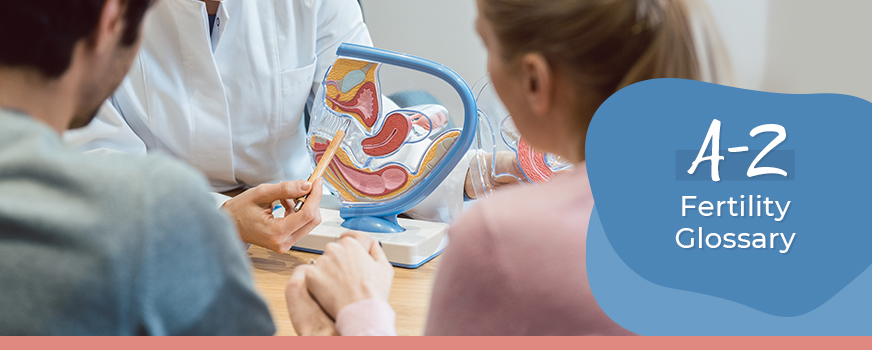
Fertility treatments can become overwhelming with the amount of information you receive. The acronyms, processes, and other fertility terms don’t have to be confusing, though! This fertility glossary will keep you feeling knowledgeable and confident throughout the process. Read below for a better understanding of IVF abbreviations and terminology you are likely to hear throughout your fertility journey.
Fertility Terms and Abbreviations
A | B | C | D | E | F | G | H | I | L | M | O | P | S | T | U | V | Z
• A •
Aneuploid embryo
An embryo with more or fewer than the normal 46 chromosomes.
Assisted Reproductive Technology (ART)
Treatments that include the handling of eggs and/or embryos. Some ART procedures are in vitro fertilization (IVF), gamete intrafallopian transfer (GIFT), and zygote intrafallopian transfer (ZIFT).
• B •
Basal Body Temperature (BBT)
Lowest body temperature occurring during rest. Daily tracking of BBT can be used for ovulation tracking purposes.
• C •
Cervix
The narrow, lower end of the uterus.
Clomiphene Citrate
An oral medication used to promote ovulation by causing the pituitary gland to release more follicle-stimulating hormone (FSH) and luteinizing hormone (LH).
Controlled Ovarian Stimulation (COS)
Stimulation of the ovaries with medication to produce the development of multiple eggs rather than the single egg that normally develops each month.
Cryopreservation
The process of freezing embryos, eggs, or sperm at a low temperature to preserve for potential later use.
• D •
Donor Eggs
Eggs taken from a fertile woman, the donor, for implantation in another woman, the recipient.
• E •
Ectopic Pregnancy
A pregnancy in which the fertilized egg implants in a location outside of the uterus usually in the fallopian tube, the ovary, or the abdominal cavity. Ectopic pregnancy is a dangerous condition that must receive prompt treatment.
Egg
A female reproductive cell, also called an oocyte or ovum.
Embryo
An egg that has been fertilized by a sperm and undergone one or more divisions.
Embryo Transfer
Placement of embryos into a woman’s uterus through the cervix after in vitro fertilization; in zygote intrafallopian transfer (ZIFT), the embryos are placed in a woman’s fallopian tube.
Endometriosis
A medical condition involving the presence of tissue similar to the uterine lining in locations outside of the uterus, such as the ovaries, fallopian tubes, and abdominal cavity.
Estradiol
A form of estrogen (the most biologically active) produced by the follicular cells of the ovary.
• F •
Fertility
The ability to conceive a pregnancy.
Fetus
The unborn offspring from the eighth week after conception to the moment of birth.
Fibroids
Noncancerous tumors of the uterine wall.
Follicle
A structure in the ovary containing an egg and the surrounding cells that produce hormones.
Follicle-Stimulating Hormone (FSH)
A pituitary-produced hormone responsible for stimulating the growth of follicles, which contain eggs. In injectable gonadotropin medications, it is the hormone that promotes follicle growth.
Frozen Cycle
A cycle in which embryos are preserved through freezing (cryopreservation) for transfer at a later date.
• G •
Gamete
A reproductive cell, either a sperm or egg.
Gamete Intrafallopian Transfer (GIFT)
An ART procedure that involves removing eggs from the woman’s ovary, combining them with sperm, and using a laparoscope to place the unfertilized eggs and sperm into the woman’s fallopian tube through small incisions in her abdomen.
Gestation
The period of time from conception to birth.
Gestational Carrier (Gestational Surrogate)
A woman who carries an embryo that was formed from the egg of another woman. The gestational carrier usually has a contractual obligation to return the infant to its intended parents.
Gestational Sac
A fluid-filled structure that develops within the uterus early in pregnancy. In a normal pregnancy, a gestational sac contains a developing fetus.
GnRH Agonists
A GnRH analogue that triggers the pituitary gland to release LH and FSH. When started at the beginning of an IVF cycle, GnRH agonists also prevent premature ovulation and stimulate follicle growth.
GnRH antagonists
A GnRH analogue that is used to prevent premature ovulation in an IVF cycle. GnRH antagonists have an immediate suppressive effect on the pituitary gland, which prevents the release of LH and FSH.
• H •
Human Chorionic Gonadotropin (hCG)
A hormone produced in the body; its detection is the basis for most pregnancy tests. hCG is also used to induce ovulation (also termed triggering ovulation) in an IVF cycle, and causes the final maturation of the egg. hCG trigger shots are given upon meeting certain criteria in an IVF cycle.
Human Menopausal Gonadotropin (hMG)
A medication that contains FSH- and hCG-driven LH activity derived from the urine of postmenopausal women. hMG is used to stimulate the growth of multiple follicles.
Hydrosalpinx
A blocked, dilated, fluid-filled fallopian tube.
• I •
Impaired Fecundity
Difficulty conceiving or carrying a pregnancy to term, including situations in which pregnancy has been deemed medically risky for the woman and/or her offspring.
Infertility
Difficulty achieving conception. In many studies, infertility is defined as the failure of a couple to conceive, despite unprotected intercourse, after a certain amount of time (usually 6 – 12 months).
Intracytoplasmic Sperm Injection (ICSI)
A procedure in which a single sperm is injected directly into an egg. This procedure is most commonly used to overcome male infertility problems.
Induced Abortion (Therapeutic Abortion)
A surgical or other medical procedure used to end a pregnancy.
Intrauterine Insemination (IUI)
A medical procedure that involves placing sperm into a woman’s uterus to facilitate fertilization. IUI is not considered an ART procedure because it does not involve the manipulation of eggs.
In Vitro Fertilization (IVF)
An ART procedure that involves removing eggs from a woman’s ovaries and fertilizing them outside her body. The resulting embryos are then transferred into the woman’s uterus through the cervix.
• L •
Laparoscopy
A surgical procedure that allows viewing of the internal pelvic organs. During the procedure, a long, narrow, fiber-optic instrument called a laparoscope is usually inserted through an incision in or below the woman’s navel.
Luteinizing Hormone (LH)
A pituitary-produced hormone that normally causes ovulation and maturation of the egg.
• M •
Male Factor
Any cause of infertility due to deficiencies in sperm quantity or that make it difficult for a sperm to fertilize an egg under normal conditions.
Miscarriage (Spontaneous Abortion)
A pregnancy ending in the spontaneous loss of the embryo or fetus before 20 weeks of gestation.
Multifetal Pregnancy Reduction
A procedure used to decrease the number of fetuses a woman carries and improve the chances that the remaining fetuses will develop into healthy infants. Multifetal reductions that occur naturally are referred to as spontaneous multifetal reductions.
• O •
Oocyte
The medical term for egg.
Ovarian Hyperstimulation Syndrome (OHSS)
A condition in which the ovaries may become swollen, sometimes as a result of controlled ovarian stimulation (COS).
Ovarian Reserve
Refers to the number of follicles (eggs) a woman has and is an indicator of her reproductive potential. Diminished ovarian reserve indicates depletion in the number of eggs.
Ovary (Ovaries)
The 2 female sex glands in the pelvis, located one on each side of the uterus. The ovaries produce eggs and hormones, including estrogen, progesterone, and androgens.
Ovulation
The release of an egg from the ovary (when the egg is expelled from the follicle).
• P •
Polycystic Ovary Syndrome (PCOS)
A common endocrine disorder in women of reproductive age in which the body’s sex hormones are not balanced, which may impair fertility. Characterized by enlarged ovaries with many antral follicles.
Preimplantation Genetic Diagnosis (PGD)
A screening test used to determine if specific genetic or chromosomal disorders are present in embryos.
Preimplantation Genetic Screening (PGS)
A test used to screen embryos for chromosomal abnormalities.
Progesterone
A hormone that, in women, is secreted during the second half of the menstrual cycle and prepares the lining of the uterus for implantation of a fertilized egg.
• S •
Secondary Infertility
Infertility in persons who have already had children.
Singleton
A fetus which develops alone in the womb is called a singleton, in contrast, the general term for one offspring of a multiple birth is multiple.
Sperm
The male reproductive cell.
Sterility
Permanent infertility.
Stillbirth
An infant delivered without signs of life after 20 or more weeks of gestation.
Stimulated Cycle
An ART cycle in which a woman receives oral or injected fertility drugs to stimulate her ovaries to produce more follicles.
Surgical Sterility
Inability to conceive or carry a pregnancy to term as a result of surgery. This category includes both the “contraceptively sterile,” people who have sterilizing operations such as tubal ligation or vasectomy, and the “noncontraceptively sterile,” people who are sterile as a result of surgery for other medical conditions (such as endometriosis, fibroid tumors or cancer).
• T •
Thawed Cycle
A cycle in which frozen embryos are thawed for transfer.
Transvaginal Ultrasound Aspiration
An ultrasound – guided technique for egg retrieval in which a needle is passed through the vagina into the ovarian follicle and suction is used to retrieve the egg.
Tubal Factor
Structural or functional damage to one or both fallopian tubes that reduces fertility.
• U •
Unstimulated Cycle
An ART cycle in which the woman does not receive drugs to stimulate her ovaries to produce more follicles. Instead, follicles develop naturally.
Uterine Factor
A disorder in the uterus (e.g., fibroid tumors) that reduces fertility.
Uterus (Womb)
The hollow, muscular female reproductive organ in the pelvis in which an embryo implants and grows during pregnancy.
• V •
Varicocele
Varicose vein in the scrotum that may affect quality and production of sperm.
• Z •
Zygote
A fertilized egg before cell division begins.
Zygote Intrafallopian Tube Transfer (ZIFT)
A procedure in which an egg is fertilized in the laboratory and the zygote is transferred to the fallopian tube before cell division takes place.
Now that this fertility glossary has informed you on all of the most important fertility terms and IVF abbreviations, approach the process of fertility with confidence and ease! If you’re currently trying or planning on adding a special little member to your family, schedule an appointment with a fertility specialist to discuss your options and learn more about the fertilization process.



